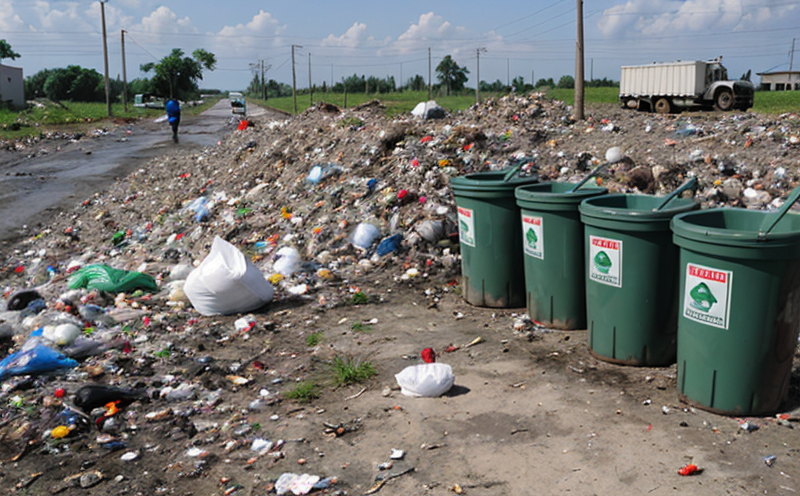ISO 21268-4 Influence of pH on Leaching Test in Solid Waste
The ISO 21268 series is a comprehensive set of standards that cover the determination of leachate from solid waste. Specifically, ISO 21268-4 outlines the procedure for determining the influence of pH on the leaching process. This test method is critical in environmental testing as it helps to understand how various pH levels affect the release of contaminants and pollutants into the environment.
The significance of this standard lies in its ability to provide insights into the potential environmental impacts of solid waste disposal practices. By simulating different pH conditions, stakeholders can make informed decisions regarding waste management strategies and ensure compliance with regulatory requirements.
Understanding the influence of pH on leaching is particularly important for industries such as municipal waste facilities, hazardous waste handlers, and landfills. These entities must ensure that their operations do not contribute to environmental degradation or pose risks to human health. The ISO 21268-4 test helps them achieve this by providing a standardized approach to assessing the potential leaching of contaminants.
The methodology involves preparing a sample of solid waste in accordance with specified conditions and then subjecting it to a series of pH adjustments. This allows for the measurement of the amount of pollutants that are released under different acidic or alkaline conditions. The results provide valuable data on the stability and potential hazards associated with the waste material.
This test is not only important for compliance but also serves as a tool for continuous improvement in waste management practices. By identifying the conditions under which leaching occurs, facilities can implement measures to reduce environmental impact. This might include changes in collection methods, storage protocols, or even the composition of the waste itself.
The ISO 21268-4 standard is widely recognized and respected within the environmental testing community. Its adoption ensures consistency across different regions and helps to harmonize practices globally. For stakeholders involved in solid waste management, this test provides a robust foundation for decision-making and risk assessment.
In summary, ISO 21268-4 is an essential tool for anyone responsible for managing or testing solid waste. It offers a standardized approach to understanding the environmental impact of pH on leaching processes, thereby supporting more sustainable practices in waste management.
Why It Matters
The significance of ISO 21268-4 extends beyond compliance; it plays a crucial role in ensuring the environmental sustainability and public safety associated with solid waste management. Here are some key reasons why this test is essential:
- Regulatory Compliance: Many jurisdictions have stringent regulations regarding the leaching of contaminants from solid waste. ISO 21268-4 provides a standardized method to ensure compliance with these laws.
- Risk Assessment: By understanding how pH affects leaching, stakeholders can better assess and mitigate potential risks associated with waste disposal methods.
- Sustainable Practices: The test helps facilities identify areas for improvement in their operations, leading to more sustainable practices that minimize environmental impact.
- Data Integrity: Standardized testing ensures reliable data, which is critical for making informed decisions and planning future waste management strategies.
In essence, ISO 21268-4 is not just a compliance tool but also a valuable resource for improving the environmental performance of solid waste management practices.
Scope and Methodology
The scope of ISO 21268-4 is limited to the determination of the influence of pH on leaching from solid waste under controlled laboratory conditions. This standard specifies a procedure for preparing samples, adjusting the pH, and measuring the amount of leachate released.
Here’s a detailed breakdown of the methodology:
- Sample Preparation: A representative sample of solid waste is collected and prepared according to the standard. This involves ensuring that the sample is homogeneous and representative of the entire batch being tested.
- PH Adjustment: The pH of the leachate is adjusted using standardized solutions, typically ranging from acidic (pH 2-3) to basic (pH 10-12). This simulates a wide range of real-world environmental conditions.
- Liquid Extraction: Once the pH has been stabilized at each level, the sample is subjected to liquid extraction methods to determine the amount of leachate released. Common techniques include shaking or stirring the sample with distilled water for a specified period.
- Analytical Methods: The extracted leachate is analyzed using appropriate analytical methods such as spectrophotometry, atomic absorption spectroscopy (AAS), or ion chromatography to quantify specific pollutants.
The results are then compared against acceptance criteria specified in the standard. This allows for a comprehensive evaluation of how different pH levels affect leaching behavior and potential environmental impact.
Quality and Reliability Assurance
- Consistent Sampling: Ensuring that samples are representative and consistent across multiple tests is crucial for reliable results. This includes using appropriate sampling techniques and equipment.
- Precision of pH Adjustment: The precision with which the pH can be adjusted directly impacts the accuracy of the test. Calibration of pH meters and use of standard solutions ensures accurate adjustments.
- Standard Operating Procedures (SOPs): Implementing SOPs for each step of the testing process helps maintain consistency and quality in results.
- Validation: Regular validation of laboratory equipment, such as pH meters and analytical instruments, ensures that measurements are accurate and reliable.
By adhering to these practices, laboratories can ensure the highest quality and reliability of their testing results. This is particularly important given the critical nature of environmental testing in solid waste management.





